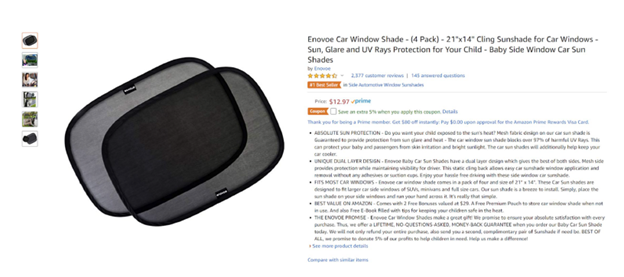How to Turbocharge Your Amazon Sales in the Automotive Category

With a broad range of products, subcategories, and sellers, Amazon is a playground for automotive enthusiasts. However, because the Automotive category is one of the more extensive on Amazon, it also presents some challenges for sellers trying to gain a foothold.
In a race against third-party sellers, first-party sellers, and Amazon itself, how do you ensure that your brand is the first past the finish line?
Here’s why there’s still a tremendous opportunity for talented sellers to come out on top: This category has seen 15% year over year growth as more consumers turn to Amazon for variety, cost, and convenience.
So if you’re currently selling or interested in selling automotive products on Amazon, read on to get the expert insights on driving winning PPC campaigns and tuning up your listings to win over customers.
The PPC Toolbox: Factors That Influence Sales and Ad Performance in the Automotive Category
To say that there are a lot of factors to consider in your Amazon advertising strategy would be an understatement. There are hundreds of tiny decisions to be made constantly when you’re launching a new product or campaign.
But, zoom out for a minute.
Before we get into the fine-tuning, let’s take a look at the big picture by breaking down this category’s conversion rates.
| No. of Transactions | Avg. Price | Conversion Rate | |
| amazon.com | 19,406,612 | 36.04 | 16.4 |
| amazon.co.uk | 8,131 | 29.15 | 5.5 |
| amazon.de | 3,426 | 34.2 | 10.8 |
| amazon.fr | 3,232 | 40.78 | 7.9 |
| amazon.es | 1,700 | 76.78 | 3.3 |
When you’re focusing on overall conversion rates in a category, you’ll want to look at two main factors: 1.) Product Variations and 2.) Price Point.
1. Product Variations:
Luckily, due to model specific restrictions, the number of product variations in the Automotive category will be fairly low. This is great because it means that buyers will spend less time in the decision making process, which makes them more likely to actually pull the trigger and make the purchase.
2. Price Point:
The average price in Automotive in the U.S. marketplace is $36.04. Typically, higher product prices require a higher level of commitment, which slows down the buyer’s time to make a final decision. So, if you have a higher priced item, you’ll get a larger return on ad spend, BUT you’ll need to spend more of that return figuring out what converts.
This is a broad look at the category and the general obstacles to conversion. Now let’s look at some specific factors that will play a role in your sales and your advertising strategy.
Summer Road Trips and Winter Tires: Understanding Seasonality in the Automotive Category
When you’re building your PPC strategy, you have to take the potential impact of seasonality into account. You’ll want to avoid driving up (see what I did there?) your ad spend on products that just won’t convert at certain times of the year.
So let’s say you’re selling in the Automotive category, and one of your products is in the Powersports subcategory. You’ll likely see a dramatic spike in sales around mid- to late-April which fall hard after the summer. Now, if another one of your products is in the Oil, Coolants, & Fluids subcategory, you’ll see a similar increase in April-May, but the drop-off will not be as dramatic.
On the other hand, if you also happen to sell Replacement Parts, you likely won’t see those same drastic peaks and valleys that coincide with different times of the year because demand remains relatively steady.
See the differences?
Another interesting thing to note here is that you may also see some differences across not just seasons but also regions. For example, sales of windshield sun shades would be at least somewhat regionally-dependent since some parts of the world remain hot year-round and others have more defined seasons.
So, in addition to addressing seasonality, you have to consider which climates create the most demand (e.g. sunny hot climate vs. rainy moderate climate).
Overall, you’ll want to note which of your products will be affected by seasonality. This insight will be crucial to not only your inventory but also your advertising strategy.
Grand Prix: Outmaneuvering the Competition to Win Market Share
As we talked about in the beginning, in the Automotive category, you may end up facing some powerful competitors in your race for the grand prize (a.k.a. increased market share). You’ll need to take into account potential competition from top brands ACDelco, Dorman, and Bosch in addition to AmazonBasics.
The good news for smaller brands that are trying to compete is that although these brands take up primary positions on market share, there are ways to make your product more appealing and steal away customers from these giants. For example, high ratings and number of reviews can communicate trust in your product, which could help you pull ahead.
For brick and mortar competitors, there’s a good chance that staple items, like microfiber cloths (which are often a top-seller) are cheaper on Amazon than at your local hardware store. When you take that into account (not to mention the time it takes to physically drive to the store and find what you’re looking for) many people prefer to look for their tools and supplies from behind their computer screen.
And finally, when it comes to competition from from Amazon itself, the company has two ways of entering a product space on its platform:
- Amazon-sourced/produced brands, one example being AmazonBasics
- Amazon-acquired brands, like home security company Blink
Amazon-sourced/produced brands tend to be somewhat generic, which presents an opportunity to smart sellers. It’s possible to make a play for market share and go up against Amazon as a third-party seller.
To grab victory directly from the e-commerce giant, you need to beat Amazon in quality.
Even with the Amazon name behind it, a product is only as good as the value it provides to its customers. Providing a great product and getting the social proof (in the form of reviews and ratings) to back it up can actually help you to come out on top.
It’s Time to Make Your PPC Campaigns Purr
Now that we have a solid overview of the circumstances you’ll need to consider as a seller in the Automotive category, let’s narrow in on advertising strategy.
Now, in general, I recommend that 15-20% of your sales should come from paid advertising. This, however, is just a rule of thumb. As any gearhead knows, it takes some fine-tuning to really get your motors purring.
If, for example, you’re promoting a new or relatively unknown product, it won’t have had enough time to perform well in organic rankings. In that case, it’s more likely that about 70-80% of those sales will come from paid.
Sales on very mature products, on the other hand, will come more from the organic side, partly because you’ll be able to transfer some of the learnings from your paid strategy into boosting your organic ranking. Plus, Amazon’s algorithm favors products with high conversions, so you’ll organically climb in rank once you start making sales.
Here’s how organic and paid traffic shakes out in the Automotive category across Amazon’s platforms:
| Organic | Paid | |
| amazon.com | 71.8% | 28.2% |
| amazon.es | 92.4% | 7.6% |
| amazon.fr | 91.0% | 9.0% |
| amazon.co.uk | 94.6% | 5.4% |
| amazon.de | 85.1% | 14.9% |
You’ll notice that in marketplaces outside of the U.S., there’s little (or no) traffic driving to products in this category coming from the paid side. This may be because some countries and cultures can be more resistant to advertising. You may also see more restrictions on imports, which will drive U.S. product prices up.
So if you’re planning to sell in marketplaces outside the U.S., make sure you do your research.
Green Light: Best Practices for Your Keyword Strategy
As you probably already know, the right keywords can make or break a campaign. (Or to use a better metaphor for this article, it’s the difference between hitting the gas and pumping the brakes.)
When it comes to keyword strategy, there are always a few category-specific considerations that you’ll want to keep in the back of your mind. First, let’s take a look at the terms that currently rank near the top in this category:
- Dash Cam
- Roku
- Bluetooth Headphones
- Dash Camera for Cars
- Soldering Iron
- Car Phone Mount
- Phone Holder for Car
- Wireless Earbuds
- Heat Gun
- Carhartt Jacket Mens
Like products, keywords may go through spikes and drops throughout the year. Carhartt jackets (#10), for example, will have a spike in popularity starting in the fall. However, I think it’s safe to say that soldering irons & heat guns are fairly stable all year round.
For these more generic keywords, it’s important to clearly define your value proposition if you want to stand out from the crowd. Because this category sees a very long list of small competitors around the more generic keywords, it will be crucial to optimize your digital shelf so that repeat customers can find and choose your brand in the future.
Tips for Tuning Up Your Listings
What makes a great listing?
A great listing helps the shopper to overcome any objections by providing clear, relevant information in an attractive format. It understands the problem that your potential customer is trying to solve and gives them the information they need to make a quick decision.
So what does that actually look like? Let’s take a look at an example:

Why It Works:
- The title is SEO-focused while still attracting readers.
-
- The title includes high volume, relevant keywords (“Car Window Shade,” “Cling Sunshade”).
- It includes examples of features (“4 Pack”) and applications (“Glare & UV Rays Protection”).
- It uses punctuation to break up the title for readability, which helps to attract even more customers.
- One potential improvement I may suggest would be to add the brand name after the main product (“Car Window Shade by Enovoe”).
- The images used in this listing are high quality and well varied.
-
- It uses a high number of images (6, to be exact).
- All images are high resolution.
- There are lifestyle images included to show the product in use.
- If I were to suggest one improvement for this aspect of the listing, it would be to include a visually appealing infographic that illustrates benefits and features as well as overcomes potential objections.
- The list of features is complete and well structured.
- The listing addresses common concerns (“Absolute Sun Protection,” “Fits Most Car Windows”).
- Each point begins with a product benefit in full capitalization before specifications.
- This is a great way to draw attention to your benefits!
- This listing offers a guarantee, which helps to overcome objections and differentiate the product from other, similar products.
To understand a potential customer’s buying triggers, you’ll need to learn what problem they’re trying to solve and what information they need to learn.
Then, once you know the buying triggers behind your audience, that knowledge will allow you to make intelligent corrections along the way, ultimately leading to a well optimized, high-converting listing.
Final Thoughts
I hope this has helped you to identify the potential pitfalls—along with the amazing opportunities—for sellers hoping to gain market share in this category.
As always, our goal is to help people become category Kings and Queens and dominate their niche—whatever that niche may be. With that being said, if you want to make some major moves, we can help. Apply below.



